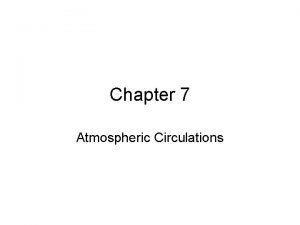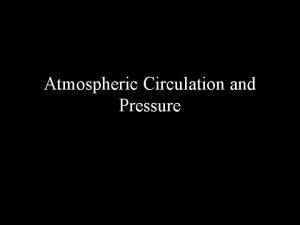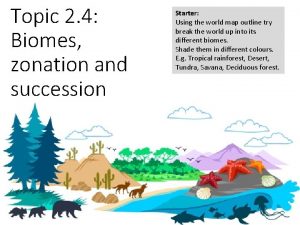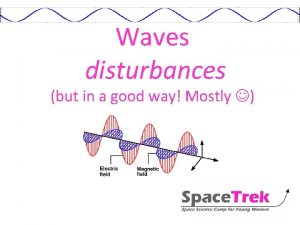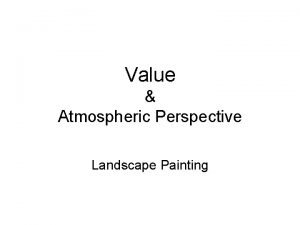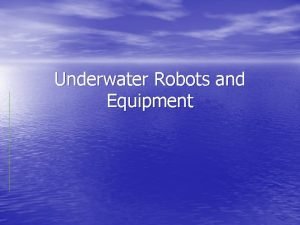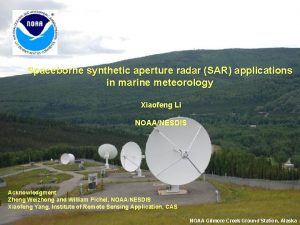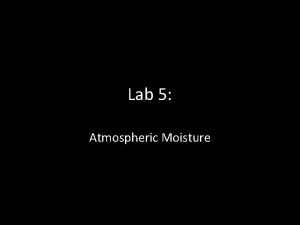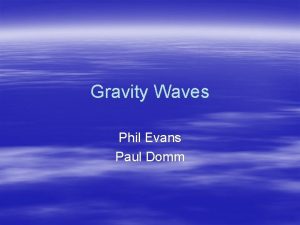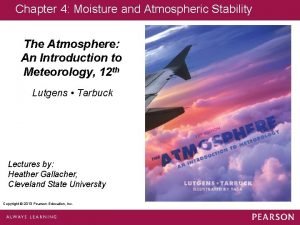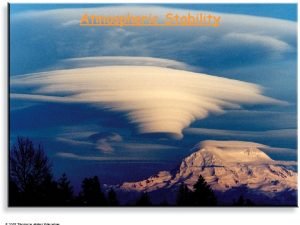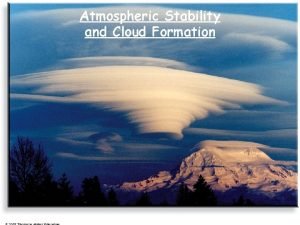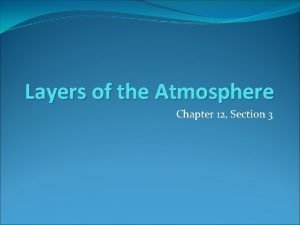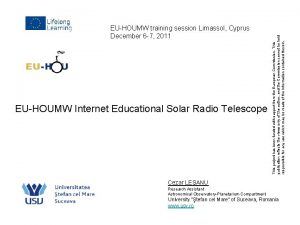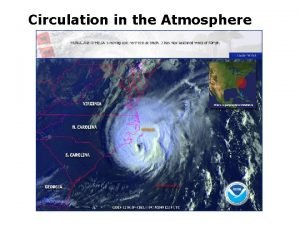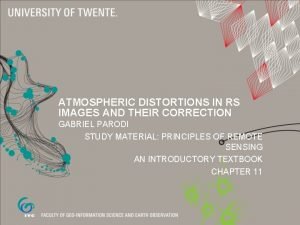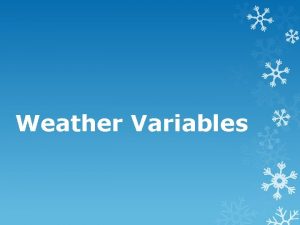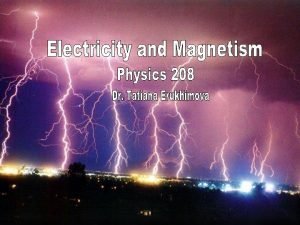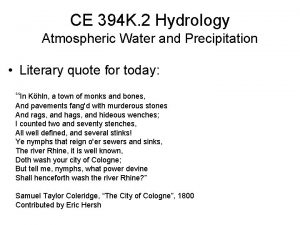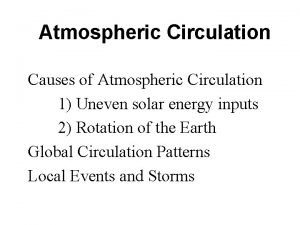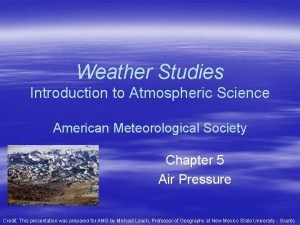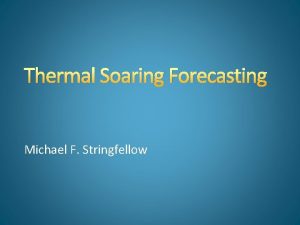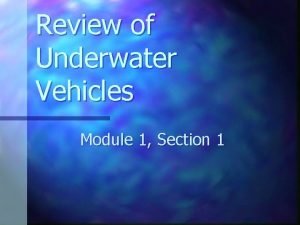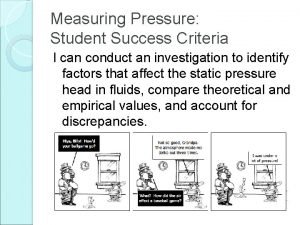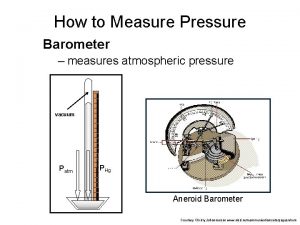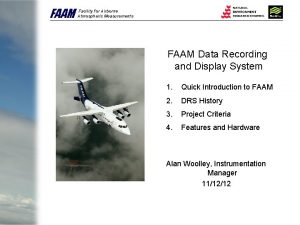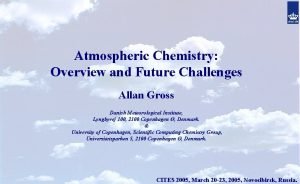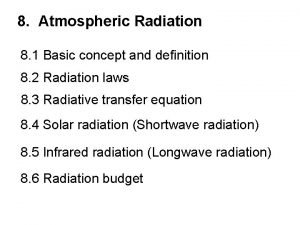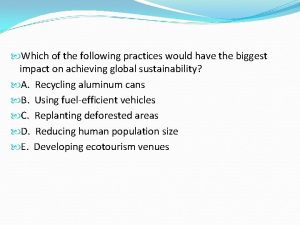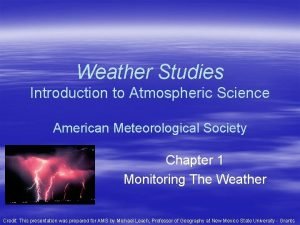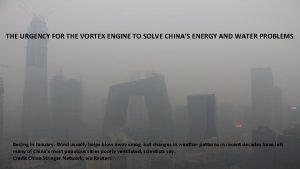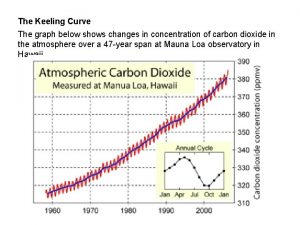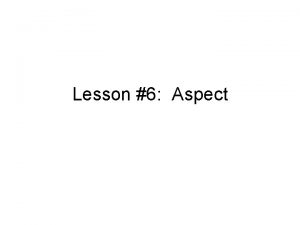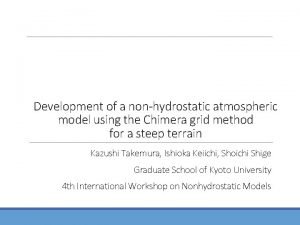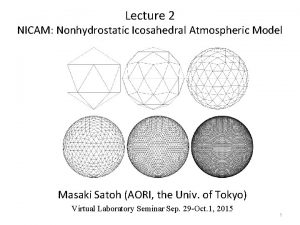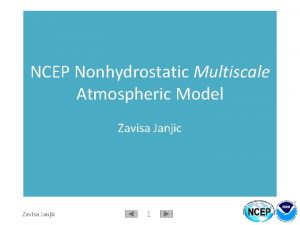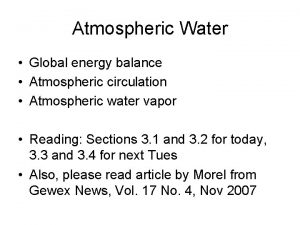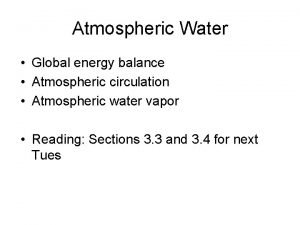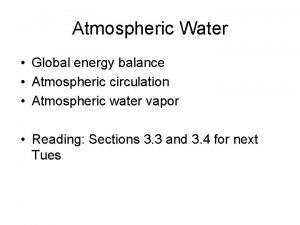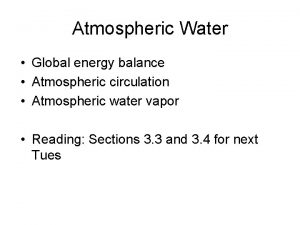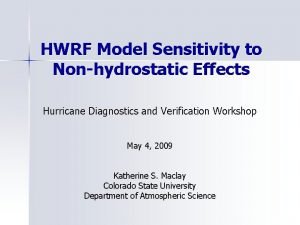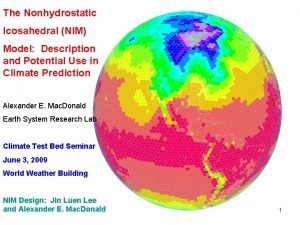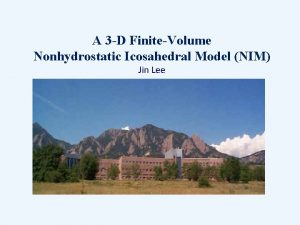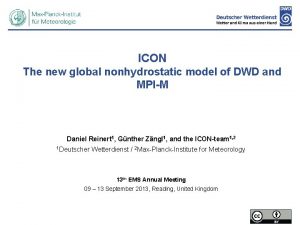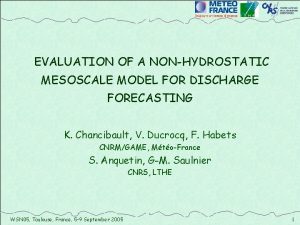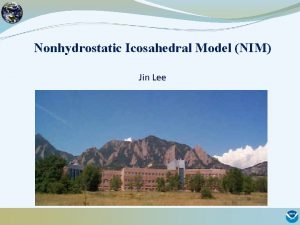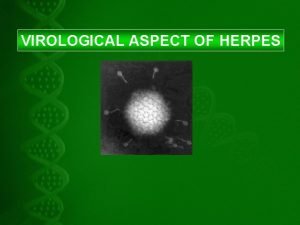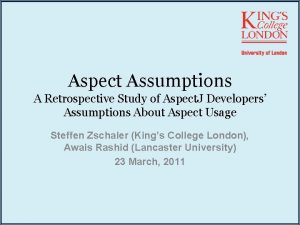A Modified Atmospheric Nonhydrostatic Model on Low Aspect














































- Slides: 46

A Modified Atmospheric Nonhydrostatic Model on Low Aspect Ratio Grids Wen-Yih Sun 1, 2 Oliver M. Sun 3 and Kazuhisa Tsuboki 4 1. Purdue University, W. Lafayette, IN. 47907 USA 2. National Central University, Chung-Li, Tao-yuan, 320, Taiwan 3. Woods Hole Oceanographic Institute, Woods Hole, MA 02543 -1050, USA 4. Nagoya University, Nagoya, 464 -8601. Japan

2. Basic Equations �

Linearized Equations �

Following Hsu and Sun (2001), we obtain .

The solutions of differential in time and difference in space are assumed: (semi-analytic= reference) We obtain the dispersive relationship:

Let define : and the gravity waves:

3. Eigenvalue of finite difference equations Modified Forwardbackward

Finite Difference form for HE-VI (Horizontal Explicit-Vertical Implicit) , =1

Eigen value for HE-VI with =1




(a) (b) Fig. 3: (a) with x=1000 m, z= 500 m, t=2. 98 s; contour interval of (dash line) is 5 x 10 -8 s-1; (b) Same as (a) except x= z= 5 m, t=1. 179 x 10 -2 s, contour interval of dot lines is 1 x 10 -7 s-1.

(a) (b) Fig. 4: (a): Initial x-component wind for Kelvin-Helmholtz instability (b) initial background (solid line) and perturbation � ’ (color) for 4. 1.


(b) Fig. 6: (a) Initial background (black) and perturbation ’ (color) for 4. 2 -4. 3; (b) Simulated ’ at t=240 s from FB with =1 (black), =4 (green), =16 (red), and HE-VI scheme (blue) with ts=0. 0025 s, tb=0. 1 s, and x= z=5 m. Contour interval is 0. 005 K.

Fig. 6: (a) Initial background (black) and perturbation ’ (color) for 4. 2 -4. 3

Fig. 6(b) Simulated ’ at t=240 s from FB with =1 (black), =4 (green), =16 (red), and HE -VI scheme (blue) with ts=0. 0025 s, tb=0. 1 s, and x= z=5 m. Contour interval is 0. 005 K

Fig. 7: (a) Simulated ’ at t=240 s from FB with =1, ts=0. 005 s (solid line); =4, ts=0. 01 s (long dash); and =16 ts=0. 02 s (short dash). Contour interval is 0. 005 K;

Fig. 7 b: ’ from HE-VI with ts=0. 005 s (dot line) and ts=0. 01 s (solid line). Contour interval is 0. 005 K.

Initial condition for KH-wave, w(black, solid), Ub(red, dash), and (green. dot) Simulated Short KH-wave at t=240 s, Forward-back(dts=. 005, black, solid), Implicit (dts=. 01 s red, dash), Mod. Forward-B (dts=. 01 s blue. dot)

Simulated vertical velocity w Short KH-wave at t=240 s, Forward-back(dts=. 005, black, solid), Implicit (dts=. 01 s red, dash), Mod. Forward-B (dts=. 01 s blue. dot)

Simulated w Short KH-wave at t=480 s, Forward-back(dts=. 005, black, solid), Implicit (dts=. 01 s red, dash), Mod. Forward-B (dts=. 01 s blue. dot)


(a) Fig. 8 (a) Initial for FB with =1, ts = 0. 008 s, x= z=5 m & tb= 0. 12 s. interval is 0. 05 K; (b) simulated and v at t=6 m; (c) t=12 m; (d) at t=18 min.

(d ) Fig. 8: simulated velocity v and ’ at (c) t=12 min; (d) at t=18 min.

(a ) (b) Fig. 9: Simulated v and at t=18 min: (a) with =16, ts = 0. 03 s; (b) with HE-VI, ts = 0. 008 s;




Table 1: Variation of change of the total mass with respect to its initial value as function of time for MFB ( =16, ts= 0. 04 s) and HE-VI ( ts= 0. 02 s). Time= 0 s 80 s 160 s 240 s 320 s [M 16(t)-M(0)] /M(0) 0 2. 84057 x 10 -6 0 7. 10142 x 10 -7 [Mim(t)-M(0)] /M(0) 0 2. 13042 x 10 -6 -7. 10142 x 10 -7 1. 42028 x 10 -6

5. Summary � Modified nonhydrostatic model (MNH) with (between 4 and 16) applied to the continuity equation can suppress the frequency of acoustic waves very effectively with insignificant impact on gravity waves, which enables to use a longer time step. � MNH is simple, in which many numerical schemes can be easily incorporated. � The eigenvalues and nonlinear model simulations of Kelvin. Helmholtz instability, mountain wave, and thermal bubble when FB is applied to MNH (i. e. , MFB) show that MFB can reproduce the results of the original NH very accurately and efficiently. � It is also found that the simulations from the HE-VI are consistent with those from FB if the time interval ts is very small, or the time variation of horizontal gradient is not as important as the vertical gradient within ts. Otherwise, HE-VI simulations can depart from the FB significantly. � MFB can use a higher-order scheme in space to simulate LES, and turbulence, etc. , which requires a fine-resolution in both horizontal and vertical directions.

Simulations of Lee vortices by WRF & NTU-Purdue Model use modified semi-implicit scheme with =4 discussed in (E) Model configuration and experiment design – idealized mountain Grid points : 600 x 50 in x, y, z directions dx = dy = 1 km dz ~ 300 m Free-slip lower boundary condition U = 4 m s-1 N 2 = 10 -4 s-2 Mountain peak = 2 km Half width lengths: 5 and 10 km (tilted by 30 degrees). Fr = V/Nh = 0. 2

Surface streamlines after 10 h NTU-Purdue WRF

Surface streamlines after 20 h NTU-Purdue x WRF

Sea level pressure after 10 h Interval 0. 05 h. Pa Interval 5 Pa NTU-Purdue WRF

Sea level pressure after 20 h Interval 5 Pa NTU-Purdue Interval 0. 05 h. Pa WRF

Procedure � The Purdue/ NTU model was initialized with the El Paso 12 Z sounding. � Model results are shown for 2 - 4 hours of model forecasts. � Also shown are Meso-g and WSMR Surface Atmosphere Measuring System (SAMS) wind and pressure observations, the White Sands Profiler and other data. � For 01 -25 -2004, both the model and observations show strong downslope winds, and a stationary wave train extending downwind from the mountains, and apparently a hydraulic jump. For 01 -19 -2004, both the model and observations show blocked flow in the lee of the Organ mountains and downslope flow to the north of the WSMR post area.

NTU/Purdue WSMR Model Domain 201 x 201 Grid @ 1 km x, y

El Paso sounding for 12 Z January 25, 2004 Scorer Parameter } } l = 3. 5 x 10 -4 l = 5. 7 x 10 -4

Observed and Modeled WSMR Pressure Perturbations for 0800 January 25, 2004 Color Lines: Purdue/NTU NH Model Pressure Perturbations (pascals) 0 to -200 Dark Bold Numbers: Observed Pressure Perturbations -175* -149 -91 -139 -103 -111* 0* -27 Grid number west to east direction E

WSMR 10 m wind field 0800 January 25, 2004 Hydraulic Jump/ Trapped Lee Waves 201 x 201 grid 1 km Grid spacing. This plot shows the central part of the model domain Wind Barbs: Purdue/NTU NH Model Dark Arrows: Observed Winds Color contours show the model terrain in m asl. Grid number west to east direction

WSMR 10 m wind field 0800 January 25, 2004 Hydraulic Jump/ Trapped Lee Waves Wind Vectors: WRF NH Model Red Arrows: Observed Winds 199 x 199 grid 1 km grid spacing. This plot shows the central part. Color contours show the model terrain in m asl

(a) wind in White Sands after 4 -hr integration, (dx=dy=2 km, and dz=300 m). initial wind U= 5 m/s; (b) Streamline (white line) and virtual potential temperature (background shaded colors) at z=1. 8 km, warm color (red) indicates subsidence warming on the lee-side, and cold (blue) color adiabatic cooling on the windward side of the mountain.

WSMR Wind Profiler Vertical Velocities NTU/Purdue model vertical velocities (connected lines) Wind Profiling Radar observed vertical velocities (+ and # ) with 0. 5 m/ sec error bars. The vertical scale is altitude in meters asl 21000 18000 Elevation of Basin Floor + 15000 #+ # # ++ 9000 3000 + + # NTU/Purdue Model Vertical Velocities at 0730 # #+ + # + # ## + # + # # 12000 6000 Average terrain height upwind WSMR Profiler 0700 -0800 + 0800 -0900 # + # 0830 + 0900 0830 0900 0730 + vertical velocity m/sec 0800 +

Conclusions * Both theory & models show that modified forward-backward scheme & semi-implicit scheme with =16 are accurate for short waves in nonhydrostatic equations. * For an the idealized mountain, the simulations from both models are similar at 10 -hrs integration, but difference becomes significant after 20 hrs integration. It is also noticed that a stagnation exists at the windward side in the NTU-Purdue model but not in the WRF. * The WSMS simulations show in the lee of the Organ Mountains, the WRF simulated wind mainly comes from the South without the formation of lee-vortices on the lee side. On the other hand, the wind simulated from the NTU-Purdue model mainly descends from the Mountains and forms the lee-vortices, which are in good agreement with observations. The vertical wind profile from the NTU-Purdue is also consistent with the observed wind according to the ARL wind profiler.
 Les aspects d'un texte
Les aspects d'un texte High pressure and low pressure
High pressure and low pressure Single cell model of atmospheric circulation
Single cell model of atmospheric circulation Single cell model of atmospheric circulation
Single cell model of atmospheric circulation Tri cellular model of atmospheric circulation upsc
Tri cellular model of atmospheric circulation upsc Mid = (low + high) / 2
Mid = (low + high) / 2 Sociability continuum
Sociability continuum Low accuracy low precision
Low accuracy low precision Low voltage = low hazard
Low voltage = low hazard Atmospheric opacity
Atmospheric opacity Atmospheric perspective landscape
Atmospheric perspective landscape Atmospheric suits
Atmospheric suits Atmospheric gravity waves
Atmospheric gravity waves Penn state meteorology
Penn state meteorology Lab 5 atmospheric moisture
Lab 5 atmospheric moisture Pressure at different altitudes
Pressure at different altitudes Forceparcel
Forceparcel Atmospheric stability
Atmospheric stability Define unstable equilibrium
Define unstable equilibrium Conditionally unstable atmosphere
Conditionally unstable atmosphere Stellar heaven
Stellar heaven Section 1 atmospheric basics continued answers
Section 1 atmospheric basics continued answers Atmospheric opacity
Atmospheric opacity Atmospheric circulation
Atmospheric circulation Atmospheric distortion correction
Atmospheric distortion correction What is a weather variable
What is a weather variable Define atmosphere
Define atmosphere Biomes
Biomes A first course in atmospheric thermodynamics solutions
A first course in atmospheric thermodynamics solutions Atmospheric convection
Atmospheric convection Atmospheric convection
Atmospheric convection Atmospheric convection
Atmospheric convection Weather studies introduction to atmospheric science
Weather studies introduction to atmospheric science Dr jack soaring forecast
Dr jack soaring forecast Atmospheric diving suit
Atmospheric diving suit Atmospheric chemistry lecture notes
Atmospheric chemistry lecture notes Pressure head meaning
Pressure head meaning Barometer at sea level
Barometer at sea level Facility for airborne atmospheric measurements
Facility for airborne atmospheric measurements Atmospheric refraction
Atmospheric refraction Atmospheric reaction
Atmospheric reaction Atmospheric
Atmospheric Exemplified by starlings displacing bluebirds
Exemplified by starlings displacing bluebirds Weather studies introduction to atmospheric science
Weather studies introduction to atmospheric science Atmospheric vortex engine
Atmospheric vortex engine Atmospheric vortex engine
Atmospheric vortex engine The graph below shows atmospheric carbon dioxide
The graph below shows atmospheric carbon dioxide


